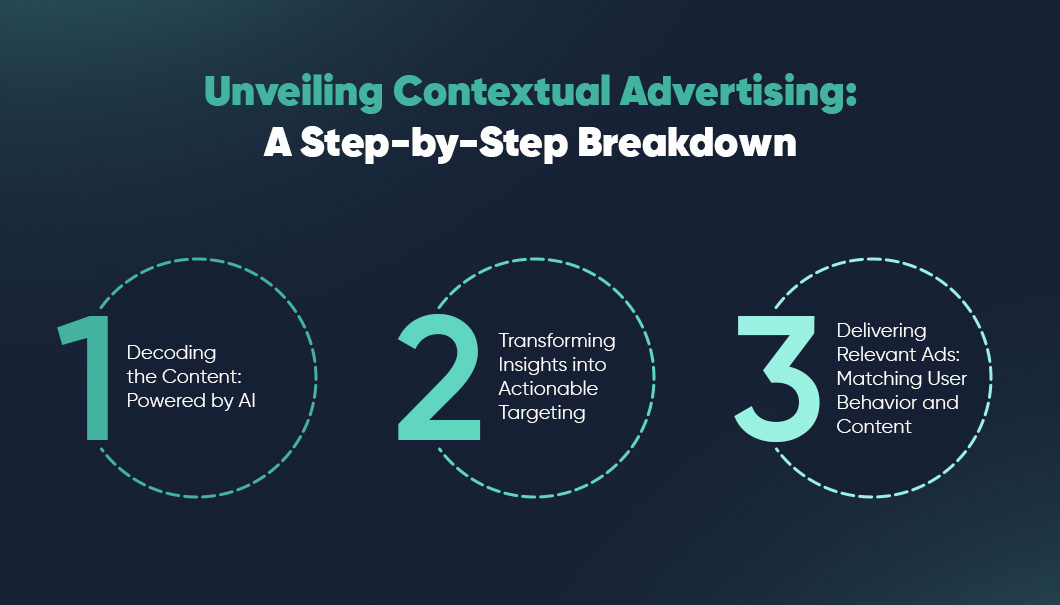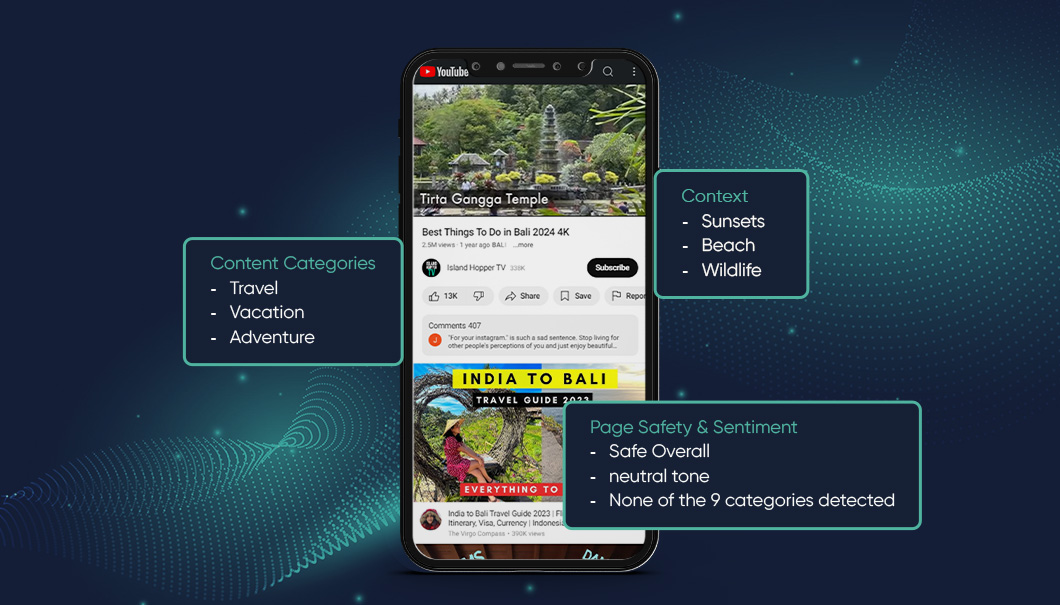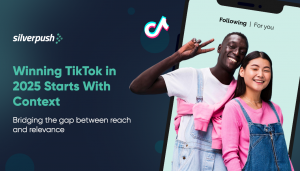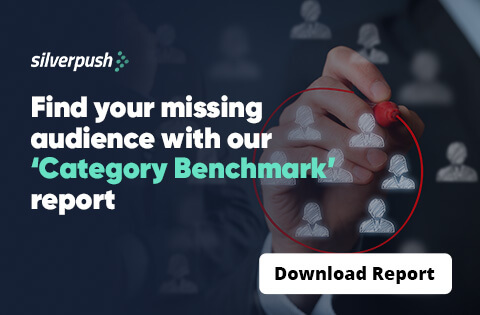Contextual Advertising Guide – Navigating the Cookieless Era | 29 Jan, 2025

Contextual advertising has been existing in the digital advertising industry for the last 20 years. It was only after the development of user-tracking techniques, that advertisers moved away from this method. However, because of the depreciation of third-party cookies and the rising need for user-data privacy, advertisers have been shifting the focus back to first-party data and the contextual targeting approach.
The Contextual Advertising market has experienced significant growth in recent years and continues to expand rapidly. Valued at $211.62 billion in 2024, it is projected to reach $233.89 billion in 2025, reflecting a robust compound annual growth rate (CAGR) of 10.5%.
In this guide, learn how contextual advertising has become the prime focus for advertisers to drive successful campaigns. The insights mentioned here will not only help you identify how to stand out in a cookieless environment but also understand how to leverage contextual targeting to reach your targeted audience.
Table of Contents
1. What is Contextual Advertising?
2. Benefits of Contextual Advertising
3. Contextual Advertising vs Behavioral Advertising
4. Statistics Highlighting the Importance of Advertising Contextually
5. Examples of Contextual Advertising – Case Study
6. Unveiling Contextual Advertising: A Step-by-Step Breakdown
7. How to Choose the Best-tech Partner for Your Next Advertising Campaign?
8. Introducing Mirrors: Your Best-Tech Partner for Contextual Advertising
9. Conclusion
What is Contextual Advertising?
Contextual advertising is a type of targeted advertising that is served to viewers based on the content or page they are viewing at that moment. For example, if a user is reading a sports article, they might see ads related to sports equipment, or athletic apparel. This approach uses the context of the content to deliver contextually relevant ads, aiming to capture the user’s attention when they are already engaged with a particular topic. By aligning advertisements with the content’s theme or subject matter, contextual advertising seeks to enhance relevance and increase the likelihood of user engagement and conversions.
Benefits of Contextual Advertising
According to a report by Epilson, 69% of advertisers feel that the deprecation of third-party cookies will have much more impact compared to regulations such as GDPR and CCPA. This positions contextual ads as a highly promising alternative to behavioral advertising. The reasons for this include:
1. Reaching the Right Audience at the Right Time: Contextual ad targeting enables advertisers to engage users based on their real-time browsing content, tapping into their immediate interests and intent. This approach ensures reaching users when they are most receptive.
2. Consumer Privacy: Unlike behavioral advertising, contextual advertising stands out by not relying on third-party cookies. By placing ads within relevant content, it respects consumer privacy ensuring that users do not feel like being tracked online.
3. Targeting Specific Audiences: Utilizing topics and keywords, contextual advertising allows advertisers to target niche audiences precisely, catering to their specific interests and preferences.
4. Accessing Real-Time Metrics: Contextual ads empower advertisers to monitor campaign performance in real-time, facilitating timely optimizations for better outcomes and reduced ad spend wastage.
5. Ensuring Brand Safety: Contextual targeting minimizes the risk of ads appearing in inappropriate contexts, safeguarding brand reputation by aligning ads with relevant content and avoiding non-brand-safe environments.
6. Creating Brand Affinity: By serving ads based on the content users are browsing, contextual advertising not only ensures a brand-safe environment but also builds brand affinity, connecting with consumers who resonate with purpose-driven messaging and shared values.
7. No annoying pop-ups: Unlike intrusive pop-up ads, contextual ads blend seamlessly into the webpage, making them less bothersome for users. Since the ads are relevant to the content they’re viewing, people are more likely to engage with them.
Contextual Advertising vs Behavioral Advertising

The main difference between contextual & behavioral advertising is that while contextual advertising shows ads based on the web page’s content, behavioral advertising serves up ads based on the user’s past online behavior & browsing history. Behavioral advertising uses consumers’ personal data to serve ads to prospective buyers, whereas contextual advertising places ads in environments that align with users’ interests and do not rely on personal data.
| Behavioral Advertising | Contextual Advertising |
| Utilizes cookies and could potentially be influenced by changing privacy regulations related to cookie usage in web browsers. | Unaffected by Privacy regulations as it does not rely on or gather cookies. |
| Relies on user search history & what sites they spend most time on. | Tailored ads based on the context of a user’s search journey to deliver relevant content. |
| May restrict control over the placement of ads on specific websites. | Advertisements are tailored to both a user’s search queries and their values, ensuring that advertising maintains integrity without compromising reputation. |
| Past behavior might not consistently reflect current relevance. | Contextual ads remain pertinent by aligning with users’ actual search activities. |
Statistics Highlighting the Importance of Advertising Contextually
- The global contextual advertising market is expected to reach $381.82 billion by 2027, growing at a CAGR of 13.3% from 2022 to 2027.
- In 2022, the U.S. was the largest player in the contextual advertising market, with a value of around $65 billion.
- 74% of marketers are using contextual data to improve their advertising post-device ID and post third-party cookies on the web.
- 79% of consumers are more comfortable seeing Contextual than behavioral ads.
- About 80% admitted they were more open to seeing ads that did not require their data.
- 62% of US marketers are using contextual marketing today. (Up from 49% in 2022)
- 42% of brands plan to increase their spending on contextual ads.
- Contextual ads are 50% more likely to be clicked on than non-contextual ads.
- Contextual ads have a 30% higher conversion rate than non-contextual ads.
Examples of Contextual Advertising – Case Study
1. In a recent campaign aimed at building inclusivity and expanding brand reach, Elf Cosmetics incorporated the power of contextual advertising. Traditional targeting methods lead to overgeneralization within ethnic groups. Without proper context and messaging, advertisers may reinforce harmful stereotypes, which can impact brand reputation.
To magnify the impact of the campaign, the company leveraged a hyper-contextual targeting solution – ensuring fair & efficient audience targeting on YouTube, enabling the brand to connect with its most relevant audience in the right context and at the right moment.

The tech identified key moments like competitor/ community-owned brand mentions, influential figures, applying makeup or skincare, and more. The brand also created an inclusion & exclusion board in adherence to GARM guidelines that did not compromise campaign reach.
Elf cosmetics witnessed a significant uplift in consideration, boasting a remarkable 69% video completion rate on YouTube—1.4 times higher than industry standards. Moreover, the brand experienced explosive search growth, with a staggering 150% YoY increase from January to June, further bolstered by a remarkable 176% surge during the campaign period.
2. Similarly, A UK sports footwear giant identified football as a popular sport to reach the target audience and drive awareness for their new product.
Recognizing the limitations of traditional YouTube targeting based on broad categories and potentially irrelevant placements, the brand adopted a more sophisticated approach. They leveraged a proprietary AI solution designed to identify key contexts within YouTube videos.
The technology specifically targeted Premier League video IDs and identified faces of popular renowned footballers, coaches, commentators, English football club logos, relevant publishers, and broadcasters. This granular targeting strategy significantly expanded the campaign’s reach and ensured ad placements within highly relevant football content, effectively aligning with the target audience’s interests.
The campaign achieved 10 Million+ Impressions and an 87% VTR, 1.08 times higher than the benchmark.
Unveiling Contextual Advertising: A Step-by-Step Breakdown

1. Decoding the Content: Powered by AI
Imagine a smart system equipped with artificial intelligence (AI). This system, called contextual intelligence, acts like a super scanner. It utilizes advanced technologies like computer vision and natural language processing to analyze every detail.
For instance, let’s say you’re browsing a post about a delicious recipe. This wouldn’t just read the text, it would also analyze the accompanying photos. It would be able to recognize the food items and the kitchen utensils pictured. By dissecting all this information, it builds a comprehensive understanding of the content’s theme.
2. Transforming Insights into Actionable Targeting
The technology continues beyond simply understanding the content. It takes that knowledge and translates it into practical applications. This is where the magic of AI comes into play. The platform uses its insights to identify the target audience most likely to be interested in the content.
Going back to our recipe example, the technology might recognize that the reader is interested in cooking. So, it would translate this understanding into actionable targeting.
3. Delivering Context Relevant Ads: Matching User Behavior and Content
Now comes the final step: ad placement. With its deep understanding of both the user’s behavior (reading a recipe) and the content itself (cooking-related), the platform can strategically place relevant advertisements on the web page.
These ads wouldn’t be random. They might be for cooking ingredients, kitchen appliances, or even online grocery delivery services – all directly connected to the user’s current interest in the recipe. In essence, the platform uses contextual intelligence to deliver highly relevant ads that seamlessly blend with the content the user is consuming.
How to Choose the Best-tech Partner for Your Next Advertising Campaign?
While selecting the ideal ad tech partner for an upcoming advertising campaign, it’s crucial to consider questions to ensure their capabilities align with the company’s objectives such as:
- What approach does the ad tech solution take towards targeting?
- Do they offer a comprehensive channel lineup or focus primarily on keyword analysis?
- Can the ad tech solution identify hyper-relevant contexts that are aligned with the campaign goals and objectives?
- Do they employ language detection models to understand slang, dialects, and cultural nuances for accurate context analysis?
- How do they ensure brand safety and suitability within your ad placements?
By seeking answers to these questions, you can gather valuable insights into a potential contextual advertising partner’s capabilities, technology ownership, effectiveness, and credibility, allowing you to make an informed decision when selecting the right partner for your advertising needs.
Introducing Mirrors: Your Best-Tech Partner for Contextual Advertising

In an era where personalized and relevant advertising matters more than ever, Mirrors empowers brands to move beyond generic targeting. At its core, it leverages advanced AI to analyze the YouTube content ecosystem, going beyond traditional keyword targeting to identify the most contextually relevant moments for your campaigns. This means your ads seamlessly integrate with the content viewers are already engaged with, creating a more meaningful connection that enhances brand recall and audience engagement.
Unlike conventional methods, Mirrors ensures your brand messaging aligns perfectly with the content’s tone and relevance, delivering ads that feel natural rather than intrusive. The proprietary AI doesn’t just focus on relevance; it also prioritizes safety. By automatically excluding unsafe or unsuitable content, Mirrors protects your brand’s reputation and ensures ads appear only in environments that reflect your values.
With precision, transparency, and control at its core, Mirrors ensures your campaigns are activated exactly where they make sense—eliminating inefficiencies and delivering unparalleled results.
Conclusion
As advertisers, navigate the evolving landscape, understanding the details of contextual advertising while using innovative technologies will be the key to unlocking new opportunities for audience engagement and campaign performance. By prioritizing contextual relevance, brand safety, and consumer privacy, advertisers can build stronger connections with their target audience growth in the cookieless era.

BLOGS
Partner Spotlight: Ben Salaman, Senior Strategist at PB&
1. Tell us about your agency. What makes you stand out? PB& is a small, independent agency that was founded by people who have spent a lot of their careers in larger agencies. We saw that creativity and efficiency often tend to suffer due to silos, so our founder decided to ...

BLOGS
How to Win at TikTok Advertising in 2025 With Contextual Targeting
TikTok is no longer just a platform for viral dances and trending audio, it’s now a serious force in the advertising world. With nearly 2 billion users and over 1.8 billion reachable through ads, it’s where your audience is spending their time. But while TikTok delivers unmatched reach, it hasn’t ...

BLOGS
Silverpush Partner Spotlight: Scott Stewart, EVP, Managing Director
This week, Silverpush is excited to feature Scott Stewart, the EVP, Managing Director at Epitaph Group. We break down what makes the agency special, why Epitaph Group chose Silverpush as a contextual partner, and, best of all, Scott’s hot take on the advertising world today. 1. Tell us about your ...







